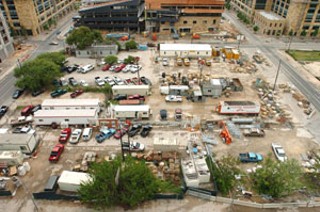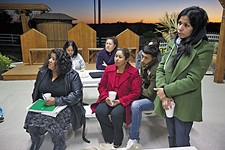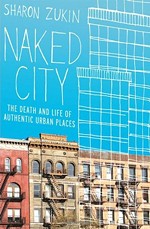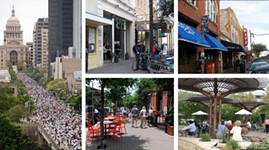The Downtown Dominoes
Will Block 21 and Seaholm start a central-city chain reaction?
By Mike Clark-Madison, Fri., April 9, 2004

This story began ... well, more than 30 years ago, when the city first bought from the state a piece of land (the site of the new City Hall) in what then really was a Warehouse District. But we can pick it up 6 1/2 years ago, when in a flush of the excitement common at the time, Mayor Kirk Watson proclaimed a Downtown Initiative – the city's first venture into public-private partnership to turn its underutilized properties into parts of the vibrant mixed-use urban neighborhood Austin said it wanted Downtown to be.
The direct fruits of that initiative are today's West Avenue Lofts (built on surplus Austin Energy land) and the just-completed AMLI residential block at Second and Lavaca. But there were other, big-picture elements of the Initiative that proved less fruitful – a Downtown plan (or at least a "vision," under the aegis of Heritage Austin); a Downtown Development Advisory Group to weigh and coordinate the possibilities for cool and lucrative projects; even some talk about a redevelopment authority with money to spend and power to make the right deals with the right developers on the city's behalf. All that got kicked to the curb a year later, when Watson decided that bringing Computer Sciences Corp. into the Warehouse District was just as effective a way to revitalize Downtown. It wasn't.
Today, we're left with unfinished – and notoriously half-finished – business in Downtown's southwestern quadrant, and that coordinated redevelopment strategy would be most helpful right about now. In the last month, the city has begun to craft such a strategy on the fly, issuing a request for proposals to redevelop Block 21 – facing the new City Hall – and committing to issue an RFP soon for the adaptive reuse of the Seaholm Power Plant. Also in the offing are efforts to study redevelopment options for Green Water Treatment Plant, between CSC and Seaholm.
The facts on the ground at Block 21 and at Seaholm couldn't be much more different, but both are among the many sites – some city-owned, some not – that could be home to some of the many things Austin wants to see Downtown: retail, residential, transportation facilities, open space, and especially cultural and civic attractions. That's why the two have become linked and why city leaders hope they'll drag the rest of the district with them. "A number of dominoes, public and private, are standing up next to each other," says Mayor Will Wynn. "If the city is smart, we will push over the first domino."
A Rubik's Cube
The projects spawned of the boom – and, in the case of urban lofts, even after – have already filled up much of Downtown's southwest quadrant. There's CSC, of course (which was originally supposed to include Block 21), and the new City Hall and the completed AMLI block (which is Block 20; these numbers refer to the city's original 1839 plat map). The West Avenue Lofts have been joined by 404 Rio Grande and the Austin City Lofts, west of the Warehouse District in what the city now calls the Market District. The hub of that neo-neighborhood – the new home and headquarters for Whole Foods Market, the latest incarnation of Schlosser Development's Sixth + Lamar project – is under construction. And a deal has been done to bury the stinking bones of the Intel building and make that site on Republic Square into the new federal courthouse.
That still leaves a lot of dominoes waiting to fall. Block 21 has a lot of sex appeal, because (as part of the CSC-City Hall deal) much of the infrastructure work has already been done, and it's almost completely unencumbered by height and density restrictions. But there's also Block 22 to the west, on which AMLI plans to build a second apartment block, though that could change. To the southeast (across from the Austin Children's Museum), property owned by MetLife (which also owns the adjacent 100 Congress) is likewise slated for apartments. North of Block 22 is the Austin Museum of Art's site on the south side of Republic Square; now that the museum has aborted its latest plans for a big showpiece facility, the options for that tract are in flux. Next door, plans are still on for Ballet Austin to turn the old Aus-Tex Printing site into its dance education center, but that's still some years away.

Across Republic Square is, among Downtown partisans, the most reviled building in town, the central post office; hopes for further redevelopment there (i.e., putting something cool on top of it) are apparently not entirely wishful. To the west along Sixth Street lies more of the former car-lot land acquired by Intel for its grand urban R&D campus, one and a half blocks of which have now been purchased by real estate pro Jill Rowe. The Schlosser project also includes fluid future plans for the block between Bowie and Shoal Creek (across from GSD&M) and for the existing Whole Foods/BookPeople complex. Across Lamar, Phoenix Properties, developers of the new 404 Rio Grande, owns the old Goodwill Industries site and is talking about an apartment tower there, and west of that, the old Tips Iron and Steel site has "mixed-use redevelopment" written all over its 5-plus acres.
Then, heading down to the lake, you arrive at the vacant tract owned by Lumbermen's Investment Corp. – home-once-removed of the Cedar Door. A mixed-use tower project there was shot down in 2001 amid political turmoil, but Lumbermen's is also a piece of the city's long-term plan (drafted by ROMA Design Group in 2000) for redeveloping Seaholm and the surrounding district, which will in turn impact options for the Green water plant.
So far, most of the plans floated for most of these parcels reflect the no-longer-very radical vision of a mixed-use neighborhood with residential, retail, and entertainment. (After the CSC and Intel debacles, the prospect of office space in the Warehouse District fills nobody with excitement.) The city is now heavily focused on inserting retail into the CSC complex – the so-called "Second Street District" – and will require its eventual Block 21 partner to build 42,000 square feet of ground-floor retail space to complete that district. So why should we worry about how the dominoes fall, if they're all likely to fall the same way? Well, what dreadfully complicates the situation here is the city and community's strong desire – some would say need – to integrate into the mix a number of civic and cultural uses that people feel should be Downtown.
Foremost among these is a new central library, which had been envisioned for Block 21 before that land was dealt away to CSC. But there's also AMOA, the Ballet Austin complex, a new studio for KLRU-TV and performance space for Austin City Limits, larger digs for the Children's Museum, and now the Texas Music Hall of Fame, which the City Council officially endorsed last week and committed to consider as a possible component of Block 21 or Seaholm. There have been over the years several other museum-type proposals for Seaholm, which has its own fan club of citizens who want to see it reserved for a nonprofit civic-destination use and may fight anything else. (No such attachments exist to Block 21.) Seaholm, or its environs, is also the most likely site for a Downtown commuter-rail station – another noncommercial use the city has already attached to the upcoming RFP.
Obviously, all these projects can't be at Seaholm or on Block 21, assuming they happen at all, but they can all be somewhere, someday. "There's a lot of moving parts, all working together," says developer Perry Lorenz, chair of the city's Downtown Commission. "It's a massive Rubik's Cube. The burden on the disposition of Block 21 has to take into account all these other things. Maybe when the solution appears, it'll be obvious. But the city can't have everything."
Wynn echoes the sentiment. "It would be short-sighted to move forward on Block 21 without a broader geographic plan and vision and some semblance of collaboration and synergy," the mayor says. "The community deserves for us to do this right, once and for all. Shame on us if we don't."
Shuffling the Pieces
The notion of a public purpose for Block 21 helped motivate the city to offer to buy the rights to the block back from CSC in 2001. Then Council Member Wynn (who, as former chair of the Downtown Austin Alliance, had special credibility on the subject) almost immediately made a pitch for Block 21 to once again be the library site. But three years later, it's almost certain that a new central library will not be built on Block 21.

Partly, the city feels Block 21 is too valuable to take off the tax rolls, and, of all its prospective civic tenants, the library would take up the most space. According to the Block 21 RFP, the land's current entitlements would allow up to 612,000 square feet of built space; a new central library, if done right, would be at least 350,000 square feet. Add in the 42,000 square feet of street-level retail required to complete the Second Street District, and that doesn't leave a lot of room for either the city or developers to make any money on a project that's typically been envisioned as combining tax generators – retail, perhaps some residential, or maybe a hotel – with a marquee civic destination.
Also, a new central library will require a bond election that won't happen before November 2005 at the earliest, and the Block 21 RFP requires that – in order to get the pieces of the "2SD" in place in a hurry – any project on the parcel break ground by the end of 2006 and be completed by 2009. "Block 21 is a perfectly appropriate site for the new central library, but the timing of when we can likely build it probably precludes that location," says Wynn. "But I'm not supportive of moving forward on Block 21 without having a new central library site defined."
For months, city leaders and library supporters have been discussing scenarios where the Block 21 deal itself "locks down a library site," in the words of City Manager Toby Futrell. "The best proposal for Block 21 needs to help us do that." This could be accomplished by earmarking the Block 21 proceeds to buy land somewhere else, or by swapping Block 21 for a suitable parcel of equal value. The RFP says nothing about a central library, but it does specifically invite land-swap offers – and other than for a central library, the last thing the city needs is to own more underdeveloped Downtown land. So "land swap" and "library site" may be two ways of saying the same thing.
The Austin Public Library Foundation still identifies Block 21 as its No. 1 potential site, and is reportedly preparing a response to the RFP, but has also been contemplating other options, most of which lie within the southwest quadrant. (There are sites under discussion farther afield, and the Block 21 RFP allows for swap offers of land anywhere between I-35 and MoPac, and north to 12th Street.) These include AMLI's Block 22 and the remaining Intel land, as well as the AMOA block on Republic Square – the latter scenario involving not a land swap, but a partnership combining the library and museum into one project.
There's also talk – spearheaded by the mayor's wife, Anne Elizabeth Wynn, an APLF board member – of killing two birds with one stone and putting the library (or at least part of it) in Seaholm. (After he dealt off Block 21, Kirk Watson also proposed that the library be built at, though not actually in, the power plant.) The dream deal, from the city's perspective, could be a swap of Block 21 for the Lumbermen's tract – allowing the Temple-Inland subsidiary to build basically the same project that got shot down on Town Lake, in a place where few would oppose it, and allowing the whole Seaholm District to be "civic" and "public" and thus appealing to its partisans, while giving the library a suitable site without saddling the city with the expensive burden of renovating and expanding Seaholm itself. Even if the library didn't go there, "the most important thing is to get Sand Beach [i.e., the Lumbermen's tract] into the city's hands," says one Downtown observer. "It doesn't matter how much it costs." Lumbermen's representatives declined to comment for this story.
As Block 21 faded as a library site, it emerged as a favored site for KLRU-TV – though not necessarily by the station itself. "We are actively looking for a new facility," says station CEO Mary Beth Rogers. "But our board is taking a very deliberate approach to this process." As far back as 2002, when the Downtown Austin Alliance formed a study group to review Block 21 ideas, a scenario combining retail with KLRU and a Texas music museum – i.e., the Texas Music Hall of Fame – topped the list, ranking higher than a library project. (An even stronger contender was a scenario that included the Children's Museum, but that prospect seems to have faded.)

"We would be terribly excited about having KLRU and Austin City Limits Downtown," says DAA executive director Charlie Betts, although he adds that "we're not micromanaging this project. ... The only thing we're really advocating for is the ground-floor retail. Beyond that, we should let the market dictate what goes there."
But since then, KLRU and ACL have become the de facto benchmark against which other Block 21 "attractions" are being measured, and breathless reports in the Statesman and rumors among Downtown players have made a KLRU deal seem but moments away from completion – to the evident exasperation of Rogers, who steps down as the station's CEO in June. "It's very important to us that we identify our funding sources before we make a commitment to any kind of project," she says. "There are rumors around, but nobody should take them seriously. We're not giving ourselves a deadline; it takes a lot of effort and money to build a television station. That's not a big sexy story, but that's the reality of where we are."
Now that the RFP is actually out, it appears that both KLRU and the Children's Museum may face the same hurdle Block 21 posed for the library – not having enough time to raise enough money to get the project under way according to the RFP's ambitious schedule. Both KLRU and the Children's Museum have also, inevitably, been touted as Seaholm tenants, although the museum's director, Gwen Crider, told the Chronicle that ACM probably can't afford the cost of renovating the power plant and would likely not respond to that RFP.
Though these and other institutions' friends and fans may want them to be – and feel they're entitled to be – in these glamorous public locations, there's still a wide gap between Austin's civic ambitions and its philanthropic performance, as one can see looking across the river at the still-not-yet-a-Long Center. "The Austin community needs to be realistic about what we can build and can support once built," says Will Wynn. "Seemingly, when we try to go from zero to 60, we spin out into the ditch."
He suggests that realism dictates that the city, its nonprofits, and its developers think differently about phasing, location, and co-location than was common in the starry-eyed years of the boom, when a lot of these ideas first emerged. "If a well-thought-out plan came forward, I can't think of a single user for Block 21 who couldn't also be happy at Seaholm, or Lumbermen's, or Intel, or on top of the post office, or AMOA, or Block 22, or wherever. Obviously, some groups will be disappointed that their use didn't make the cut on Block 21. But that should be mitigated if they know their long-term destination."
Brokering the Assets
The restrictions the RFP imposes on respondents are fairly minimal, and the minimum asking price of $9.2 million is not exorbitant – in per-square-foot terms, that's more than Intel paid for its property, but substantially less than Cousins Properties paid when it bought Block 42 (from a partnership including Will Wynn) as the site of what is now the new Frost Bank Tower. Though the RFP makes the ground-floor retail component non-negotiable, there is some grumbling about the amount and type of space it requires, as well as the stipulation that the developer hook up with HSM Urban Partners, the Second Street District development consultant. "The ground floor is where a lot of the developer's value is," says another Downtown-watcher, "and the RFP asks people to turn over control of it, for a long time, to someone from Dallas they may not know."
The 2SD was conceived as part of the CSC deal, and most of its remaining space – more than 100,000 square feet in the CSC and AMLI buildings, as well as a "City Store" in City Hall – is supposed to be finished and occupied by August 2005. Given that the Downtown retail market has never exactly been fiery, despite repeated attempts to pump it up, and with other shopping projects like Schlosser's also in the pipeline, some Downtown players argue (though not on the record) that the 2SD may be an idea whose time has already gone. But the city, CSC, and AMLI have already absorbed, and have been able to share, costs like structured parking and utility infrastructure that a typical developer would have to recoup in rent, meaning the 2SD may be able to succeed where others haven't yet by competing on price for tenants.
Even so, nobody seems convinced that the 2SD retail will itself draw a sufficient number of free-spending taxpayers to the Warehouse District, hence the desire for "cultural and entertainment attractions" on Block 21. "You need to know who the anchor is going to be, because Block 21 has to be that magnet," says Council Member Brewster McCracken. But he also notes that Seaholm, "because it's an interesting Art Deco building, seems better suited to being a cultural gathering place" – and, as well, a rail station.
Between the cost of renovation – "as much as the place is worth, at least," one Downtown observer estimates – and the requirement that Seaholm include a transit hub, as well as the political sensitivity attached to both Seaholm and the lakefront, it's unlikely the city will get either as many or as varied offers as it will on Block 21. Indeed, for the latter site, the question becomes how to decide between a full basket of apples and oranges. "The whole point of the RFP was to leave it very open and broad so we can hear all types of proposals; we didn't want to narrow or cut off any ideas," says Futrell. "There may be one that has more retail, one that goes toward bringing in a strong mixed-use (residential) component, one that adds the greatest property-tax increase, one that brings the strongest cultural element for the Second Street corridor, one that helps us lock down a library site. But I think when we see them, it's going to be clear which one is the right one. The community will know what's the right fit."
But it would be easier to know this if we knew what could fit in all the other Downtown holes – or, alternately, whether all the dominoes would fall in the same direction. Which brings us back to Wynn's call for an as-yet-undefined process for weighing all the public and private options for finishing what Kirk Watson started six years ago. "Everyone has assets," Wynn says. "Some of the organizations have land, some have money, some have more credibility; the city has some land, some bond capacity, and decision-making authority. So let's have all the information on the table and then try to hash it out. Egos will need to be left at the door, and cards laid on the table." ![]()
Got something to say on the subject? Send a letter to the editor.












